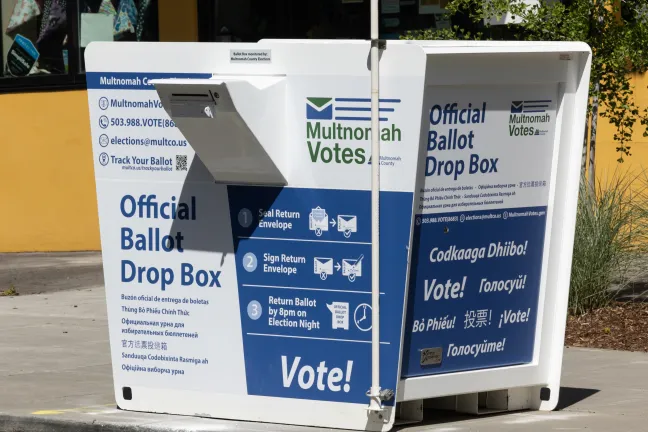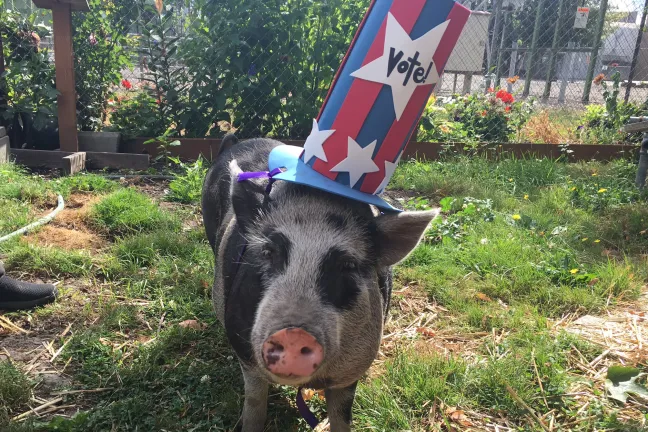The Multnomah County Board of Commissioners were updated on preparations, latest technology, outreach and the number of voters who’ve registered for this year’s presidential election.
With the implementation of the Oregon Motor Voter Act or OMVA, which automates voter registration while obtaining or renewing a driver licenses, more than 36,000 people have registered to vote through the Oregon Motor Voter automatic registration process in Multnomah County alone since January 1, explained Multnomah County Elections Director Tim Scott to the board on Tuesday. “I saw a report a couple weeks ago that statewide over 250,000 mailers were sent out with increasing registration on the state level as well.”
Elections officials anticipate voter turnout will reach historic levels for the November elections.
In preparation, Scott said, steps have been taken to reduce lines and make the voting process easier like offering extended hours and services like the Order Ahead Replacement Ballots, where voters can go online and request a replacement ballot or call into the phone bank to have a replacement ballot waiting at will call. Voters can also sign up for the Track Your Ballot service which sends text, email or voice alerts on the status of ballots.
For the Elections Division, the May Primary was the first countywide election using their new digital imaging ballot tally system, ClearVote, which scans and captures high-resolution images of paper ballots, then provides instant visuals to allow elections workers to determine voter intent.
“What we are paying for is much smarter software that helps us tally images rather than ballots as we used to do. We used 20 percent less temporary labor than we did in 2014 and that’s all because of process changes related to the tally system.”
Previously, opening boards or bi-partisan groups of four, would inspect ballots for issues like overvotes (too many ovals filled in on an office or measure) or stray pen or pencil marks to determine voter intent. Now, all ballots are scanned, then grouped together by the ClearVote system. A digital image produced by the system allows adjudication boards to determine voter intent.
The process in particular, Scott noted, has expedited the adjudication of write-in votes by allowing elections workers to digitally, not manually record names of write-in votes. Before opening boards would transfer votes from ballots to tally sheets.
With questions raised about the security of elections, Scott reassured board members about the security of the ballot counting room which is physically and electronically isolated and monitored around the clock. The ballot counting system is a stand-alone system and is not connected to the internet or any other network.
The Elections Division was also recently recognized during a U.S. Elections Assistance Commission hearing for its extremely thorough testing of its new ballot tallying system before its first use in a countywide election.
“I want to assure you we are taking every reasonable security precaution as we do with every election we conduct. This is not a new conversation. From our stand-point this is just another election and thorough security procedures are part of every election.”
Catherine McMullen, Voter Education and Outreach Specialist also updated the board on outreach efforts and education opportunities that exist for voters, particularly those in underrepresented communities.
After conducting a countywide phone survey and focus groups with frequent and infrequent voters in east county, all of them in underrepresented populations - 73 percent of voters knew that a ballot signature must match the signature on file with the Elections Division in order for it to count, 54 percent of voters knew that a stamp is required on the ballot envelope in order to mail it and just under half of voters were sure that ballots must be received by 8pm on Election Day and postmarks do not count.
“There is an opportunity for education,” McMullen said.
McMullen told board members about some of barriers to voting, identified by underrepresented groups, including: missing voter registration or election day deadlines and limited english proficiency and/or literacy. Some were unaware that their ballot had been rejected and did not know how to seek help. Others were ill, hospitalized or traveling and unaware that they would have benefited from absentee ballots.
So far, the Elections Voter Education and Outreach team has attended more than 100 outreach events, educational workshops, community meetings and festivals and connected with 4,000 current and future voters. McMullen said, they have helped update registration records, answered questions and helped the public understand their right to vote.
“One veteran said I can’t register because I have a felony in Arizona,” recalled McMullen of an interaction with a veteran who was unaware he could register to vote. “I said, ‘You served your time and have been released from prison correct? He said, yes almost 30 years ago.’ I let him know that in Oregon once you’ve been released from prison you have the right to vote again.”
In addition to voter outreach, the Elections Division is hosting a targeted #PawstoVote campaign with Multnomah County Animal Services. An event will be held at Multnomah County Animal Services Tuesday, September 27 (National Voter Registration Day) to promote voter registration and awareness with the help of pets. A special appearance will be made by Secretary of State Jeanne Atkins and the winners of a the #PawstoVote spokespets contest Jeffrey the Pig and Piper the Chihuahua will be on hand to help register voters. Adoptable pets will also be available at waived or discounted adoption fees.
“Our priorities as we have gotten started and moving into this fall election, are to continue to build relationships with community leaders and culturally-specific organizations, expand access to voters who speak languages other than English through the translation of vital documents and interpretation and to be a trusted resource for authoritative elections and voting information,” said McMullen.


